View Avalanche deaths in B.C. since 2009 in a larger map
Backcountry snowmobilers have accounted for the largest number of avalanche related-fatalities in Canada for the last three years, a statistic the Canadian Avalanche Centre attributes in part to a growing trend in the use of the machines.
Between 2008 and 2010, 31 snowmobilers died in avalanches in Canada, while only 17 skiers were killed during the same time period, data from the centre based in Revelstoke, B.C., shows.
But John Kelly, operations manager of the centre, says fatality statistics in the backcountry are prone to sudden spikes and he cautions against drawing any long-term conclusions.

The chance of encountering an avalanche depends on the weather and varies dramatically year to year. ((CBC))
"I think the simplified sound byte stories are one thing but the reality is that we don't know the underlying demographics. We don't know how many people are out there doing these sports, we don't know the risk," said Kelly.
The increase in the number of sledding fatalities can be attributed to a number of factors, he said, noting first the growing popularity of the sport.
A 2005 CAC study found that snowmobilers make up anywhere between 40 and 95 per cent of all backcountry use. The centre has noticed an increase in the number of sledders, a trend that partially explains the increase in fatalities, Kelly said.
"If they are exposing themselves as much to avalanche terrain, it's natural that there will be more sled accidents," he said.
Recent advances in sledding technology are also helping to increase the risk.
Staying safe
Backcountry enthusiasts should remember three things to stay safe, says John Kelly of the Canadian Avalanche Centre.
The first is knowing how to identify avalanche terrain.
Kelly says two-day courses designed to show people what to look for and what to avoid are offered in Eastern and Western Canada as well as in Nunavut.
Second, local avalanche information should be consulted before going out, and people should be willing to change their plans according to conditions.
Finally, take avalanche gear and know how to use it. All backcountry enthusiasts should take a shovel for digging, a probe to test snow conditions and a beacon so rescuers can quickly locate victims.
Kelly says the majority of avalanche victims die of asphyxiation and need to be located within 15 minutes. Waiting for rescuers to arrive is usually not an option.
"Over the past decade, the machinery has been very good and it's relatively easy for a novice rider to set themselves on a sled and get into very aggressive avalanche terrain," Kelly said, adding that as a result of the growth in the sport there are more groomed trails that can easily take users towards potentially dangerous areas.
Another contributing factor is the lack of proper safety gear carried by sledders, although that trend has also been changing. Kelly said around 30 per cent of snowmobilers do not carry the proper safety gear — a beacon, a probe and a shovel — compared to about half who did not just five years ago.
"The number that are equipped is rising but it's still not up nearly to the levels of where skiers are," he said. Data suggests that almost all of the skiers who die in avalanches were carrying the proper safety gear, he said.
The chance of encountering an avalanche depends on the weather and varies dramatically year to year. The risk is highest following periods of storminess and snowy conditions alternating with calm and cool periods.
The years 2008 to 2010 featured a snow pack in Western Canada that was extremely dangerous, greatly increasing the risk of an avalanche. It is too early to make any predictions for this year but Kelly said he is "cautiously optimistic" about current conditions.
Although snowmobilers represent the majority of avalanche deaths, Kelly said backcountry and out-of-bounds skiers are a close second and third.
But most of these outdoor enthusiasts are aware of the risks and plan accordingly, he said.
"There are lots of people who have been recreating in the mountains completely safely for their entire lives."



















